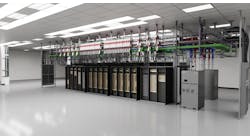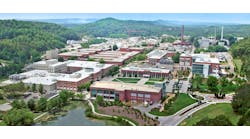President Biden's Executive Order on AI Data Center Construction: Summary and Commentary
Issued this week, President Biden’s “Executive Order on Advancing United States Leadership in Artificial Intelligence Infrastructure” represents a transformative policy moment for the data center industry if implemented, underscoring the convergence of two equally transformative forces: the AI revolution and the clean energy transition.
For the data center industry, the policy marks a clear shift toward a strategic, mission-critical role in national security and economic resilience. The Executive Order’s vision also aligns with definitively emerging trends in the contemporary data center industry, particularly the pivot toward sustainability and energy efficiency.
The policy’s emphasis on clean energy infrastructure—whether through nuclear, geothermal, or long-duration storage—addresses the industry’s growing focus on renewable power. However, executing this vision will require massive investments in grid modernization and streamlined permitting processes, which have historically been bottlenecks for large-scale infrastructure projects.
The directive to align new AI electricity demands with clean energy sources puts a spotlight on the challenges posed by AI’s computational intensity. Hyperscale operators and colocation providers will need to redouble their rethinking of power procurement strategies, with a renewed focus on distributed energy resources and partnerships with utility providers.
Additionally, the Executive Order’s call for high labor standards and community engagement reflects growing federal acknowledgment of data centers' societal footprint. While the industry has made strides in community outreach, such measures ensure data center developments are not just sustainable but also equitable, creating jobs and fostering goodwill in the communities where they operate.
For what it explicitly defines as “frontier AI data centers,” the Executive Order also seeks to provide a regulatory framework to streamline development, while ensuring robust cybersecurity and supply chain integrity. Importantly though, balancing the urgency of AI infrastructure development with the complex demands of energy transition and national security will require unprecedented levels of public-private collaboration.
The Executive Order apparently isn’t just a directive, but is clearly meant as a roadmap for the data center industry to lead not just technologically, but also ethically and sustainably, in the AI age. The challenge will be in the plan’s execution: ensuring the ambitious goals outlined are matched by swift, decisive action across all stakeholders.
Let’s now break down and summarize each section of the new Executive Order.
Section 1: Purpose
The opening section of the directive emphasizes the strategic importance of artificial intelligence (AI) for U.S. national security and economic competitiveness. It highlights the need to build AI infrastructure domestically to prevent reliance on foreign systems and protect against adversaries.
The development of AI requires significant private-sector investment in advanced computing clusters and energy resources. The order ties AI development to leadership in clean energy technologies and underscores the importance of secure supply chains, labor benefits, community collaboration, and maintaining affordable electricity costs.
Section 2: Policy
The directive's policy prescription establishes five guiding principles for AI infrastructure development in the U.S.:
- National Security: Strengthening AI's role in national security through secure labs and risk management of future AI capabilities.
- Economic Competitiveness: Fostering a fair, vibrant, and competitive AI ecosystem that includes support for small developers and entrepreneurs.
- Clean Energy Leadership: Aligning AI data centers with clean energy technologies like nuclear and geothermal power, ensuring electricity demand is matched with new clean energy sources.
- Energy Affordability: Preventing AI infrastructure growth from leading to increased energy costs for consumers and businesses.
- Worker and Community Benefits: Ensuring that the workforce and local communities benefit from the buildout of AI infrastructure through high labor standards and collaborative engagement.
Section 3: Definitions
This section of the document provides detailed definitions of key terms, including "AI data center," "AI infrastructure," "clean energy," and "frontier AI infrastructure."
These definitions clarify the scope of the order, addressing facilities, technologies, and regulatory terms relevant to the development of AI infrastructure.
Section 4: Establishing Federal Sites for AI Infrastructure
This section provides a robust framework for advancing frontier AI infrastructure while addressing key environmental, social, and technical considerations. It outlines a roadmap for identifying, preparing, and leasing federal lands for the development of frontier AI data centers and associated clean energy facilities.
Section 4 also emphasizes interagency collaboration and adherence to ambitious timelines for site identification, legal clearances, and solicitations. Below is an outline of the key provisions:
- Identification of Sites (Subsection a):
- By February 28, 2025, the Secretaries of Defense and Energy must identify at least three federal land sites each for potential leasing to private entities for AI data center and clean energy facility development.
- Priority is given to sites meeting criteria such as:
- Suitable terrain and topography.
- Minimal adverse impact on local communities, resources, and ecosystems.
- Proximity to transmission infrastructure, high-capacity telecommunications networks, and communities supporting AI infrastructure.
- Avoidance of areas with significant air quality issues or restrictive permitting requirements.
- Clean Energy Support (Subsection b):
- By March 15, 2025, the Secretary of the Interior must identify lands managed by the Bureau of Land Management (BLM) suitable for clean energy projects that can support AI infrastructure.
- Priority is given to lands with existing or planned clean energy projects, proximity to transmission lines, and favorable conditions for permitting and development.
- Geothermal Zones (Subsection c):
- At least five Priority Geothermal Zones (PGZs) must be designated by March 15, 2025, based on geothermal power potential, geological diversity, and other suitability factors.
- Legal Clearances (Subsection d):
- Relevant Secretaries must determine whether identified sites are legally available for lease or rights-of-way issuance.
- Competitive Solicitations (Subsection e):
- By March 31, 2025, Defense and Energy Secretaries must launch solicitations inviting private entities to lease and develop AI infrastructure on cleared federal sites. Applicants must submit detailed technical and security plans.
- Public Disclosure (Subsection f):
- The Secretary of the Interior will publicize the details of identified and cleared clean energy sites by March 31, 2025.
- Proposal Selection (Subsection g):
- Winning proposals must be announced by June 30, 2025, with at least one proposal awarded to a consortium of small- or medium-sized organizations, provided it meets qualifications.
- Selections will consider competition and market impacts, with input from the Attorney General and Federal Trade Commission.
Section 5: Protecting American Consumers and Communities
This section outlines measures to ensure AI data center development does not negatively impact energy costs or local communities. Key provisions include:
- Electricity Cost Impacts: The Secretary of Energy must report on how AI data centers affect electricity prices, focusing on promoting clean energy use without raising costs for other consumers, especially in areas with high AI infrastructure density.
- Technical Assistance: State public utility commissions will receive support to develop rate structures that enable clean energy use by AI infrastructure without causing price hikes.
- Efficiency R&D: Federal agencies will expand research into improving AI data center energy efficiency, including cooling, hardware optimization, and beneficial uses for waste heat.
- Community Engagement: The Office of Management and Budget (OMB), in consultation with other agencies, will evaluate and recommend public participation practices to address potential health, safety, and environmental impacts of AI data centers.
Section 6: Facilitating Electric Grid Interconnections for Federal Sites
This section addresses the infrastructure needed to connect AI data centers to clean energy sources and the electric grid. Key provisions include:
- Transmission Reporting: The Secretary of Energy will require transmission providers to report on available capacity, clean energy projects, and interconnection opportunities to support AI data center needs.
- Prioritizing Interconnection Points: A list of underutilized grid interconnection points with high potential for supporting AI infrastructure will be developed.
- Grid Upgrades: The Secretary of Energy, in coordination with other agencies, will engage transmission providers to identify and implement necessary grid upgrades to support AI infrastructure by 2027, prioritizing clean energy and cost reduction.
- Feasibility Analysis: A comprehensive analysis of transmission infrastructure and the costs and feasibility of connecting AI data centers to clean energy will be conducted.
Section 7: Expeditiously Processing Permits for Federal Sites
This section emphasizes streamlining the permitting process for constructing and operating AI infrastructure on federal sites, ensuring timely completion while adhering to environmental and statutory requirements. Key provisions include:
- Prioritizing Federal Permits:
- Federal agencies must expedite permitting and approval processes, aiming to complete all necessary permits by the end of 2025.
- The Permitting Council may coordinate efforts for eligible AI projects under federal jurisdiction.
- Streamlined NEPA Reviews:
- Agencies will allocate dedicated personnel to perform environmental reviews under the National Environmental Policy Act (NEPA).
- A programmatic environmental review will analyze the broader impacts of AI infrastructure construction, leveraging existing studies to accelerate evaluations.
- Air Quality and Water Permits:
- The EPA will engage state and local authorities to enhance understanding and facilitate air-quality permitting for AI infrastructure.
- The Department of Defense will expedite water-related permits through the U.S. Army Corps of Engineers while applying general permits where appropriate.
- Tribal and Ecological Consultations:
- Consultations with Tribal governments and the U.S. Fish and Wildlife Service will ensure AI infrastructure projects do not harm endangered species or critical habitats, aiming for resolution within 90 days when feasible.
- Advancing Geothermal Energy Development:
- The Department of the Interior will expedite environmental reviews and permitting for geothermal projects on federal lands, leveraging categorical exclusions and prioritizing clean energy development to support AI infrastructure.
Section 8: Ensuring Adequate Transmission Infrastructure for Federal Sites
This section outlines a comprehensive plan to ensure that frontier AI data centers on federal sites have reliable transmission infrastructure. Key elements include:
- Transmission Upgrades: By 2027, the Secretary of Energy, in collaboration with other departments, will develop and upgrade transmission infrastructure to support AI data centers.
- National Interest Corridors: Identifying geographic areas around AI infrastructure as priority corridors to address transmission constraints.
- Advanced Grid Technologies: Deploying technologies like high-performance conductors to enhance grid performance and cost-effectiveness.
- Supply Chain Support: Partnering with domestic manufacturers to forecast and stabilize the supply of critical grid components such as transformers and switchgears.
- Interconnection Transparency: Gathering and sharing data on transmission congestion to streamline interconnection processes.
- Support for Financing: Evaluating federal loan authorities to finance AI-related infrastructure upgrades and supply chain enhancements.
Section 9: Improving Permitting and Power Procurement Nationwide
This section accelerates permitting and development of AI infrastructure by specifying plans for:
- Dedicated Permitting Staff: Establishing specialized teams in federal agencies to handle AI-related infrastructure permits.
- Streamlining NEPA Reviews: Expanding categorical exclusions under NEPA for projects like fiber-optic cable deployment and clean energy installations.
- Colocation Opportunities: Identifying existing power plants with surplus interconnection capacity for AI infrastructure.
- Support for Nuclear Power: Publishing a prioritized list of sites for nuclear power deployment to meet AI data center demands.
- Supply Chain Resilience: Recommending policies to address risks in the data center supply chain, including materials and emerging technologies.
- Distributed Energy Solutions: Developing contracts to integrate distributed energy resources (DERs) into AI infrastructure.
- Reporting Requirements: Proposing new standards for monitoring greenhouse gas emissions, water use, and energy efficiency metrics in AI data centers.
Section 10: Engagement Abroad
The order emphasizes international collaboration for the U.S. in the areas of:
- Global AI Infrastructure: Partnering with allies to expand trusted AI infrastructure globally.
- Clean Energy Deployment: Promoting clean and emerging technologies like small modular nuclear reactors for international AI projects.
- Export Facilitation: Identifying and supporting U.S. exports related to advanced nuclear technologies and supply chain services.
- Best Practices Exchange: Sharing knowledge on permitting, clean energy deployment, and workforce development for AI infrastructure.
Ambitious Timelines Meet Balanced Criteria
The ambitious timelines outlined in Section 4 of the directive (e.g., identification of sites by early 2025 and data center operations by 2027) underscore the urgency of scaling AI infrastructure while adhering to rigorous permitting and development requirements. However, these deadlines could prove challenging given the complexity of federal land management and permitting processes.
The criteria for site selection reflect a balanced approach, addressing environmental concerns, community impact, and logistical feasibility. This comprehensive framework demonstrates a commitment to responsible development while enabling efficient project execution.
Further, the directive's explicit link between AI data centers and clean energy facilities highlights the administration’s dual goals of technological advancement and climate-conscious development. The inclusion of Priority Geothermal Zones also indicates a forward-thinking approach to energy diversity.
The attention paid to geothermal energy development is especially noteworthy, as it underscores the administration's commitment to diversifying clean energy sources for data centers. Geothermal energy, while less common than solar or wind, offers a consistent and sustainable energy supply that could play a pivotal role in powering the next generation of AI workloads.
Meanwhile, by reserving at least one award for small- or medium-sized enterprises, the order promotes inclusivity and competition within the AI ecosystem, potentially fostering innovation and reducing market concentration.
Collaboration and Public Engagement
Interagency collaboration and oversight is a key feature of the plan, with roles for Defense, Energy, Interior, and regulatory bodies like the Federal Trade Commission. The success of the initiative appears to hinge on efficient interagency collaboration and clear, actionable guidance for private entities. This coordination will be essential to balancing competing priorities, such as national security and environmental stewardship.
Potential obstacles to the plan at this level may include: legal and bureaucratic delays in clearing federal sites for leasing; difficulties in aligning clean energy projects with data center requirements within tight timelines; and ensuring the selected proposals meet rigorous standards without disadvantaging smaller players.
Meanwhile, the Executive Order's focus on consumer protection and community engagement as outlined in Section 5 reflects growing federal awareness of the broader implications of AI data center development.
The directive acknowledges that energy consumption clearly remains one of the most significant challenges for the data center industry, particularly as AI workloads demand increasingly power-intensive infrastructure.
By prioritizing clean energy procurement and technical assistance for states, the government aims to mitigate energy cost pressures while promoting sustainability.
The Race Toward AI Infrastructure
The inclusion of Section 7 is a clear nod to the critical need for speed in building AI infrastructure while navigating the complex regulatory landscape.
For the data center industry, permitting delays have long been a bottleneck, particularly for projects requiring significant energy and land resources. By prioritizing federal permits and leveraging programmatic reviews, the government aims to provide much-needed predictability and efficiency to developers.
Meanwhile, the plan’s focus on streamlining NEPA reviews aligns with the industry's growing emphasis on balancing rapid growth with environmental stewardship. By incorporating existing studies and applying categorical exclusions where feasible, federal agencies can fast-track approvals without sacrificing ecological considerations.
The plan's real innovation may lie in its collaborative approach to air quality, water permits, and Tribal consultations. Engaging local and Tribal stakeholders early in the process will not only address environmental justice concerns, but may also foster greater community trust in projects that often face public scrutiny.
For the data center sector, the overall directive represents both a challenge and an opportunity. The ambitious 2025 permitting deadline will test the industry's ability to scale responsibly. Yet, with the right partnerships and a clear regulatory framework, this initiative could set a new benchmark for integrating advanced infrastructure into the federal landscape efficiently and sustainably.
A Defining Moment
The bottom line is that President Biden's Executive Order marks a defining moment in the intersection of AI, clean energy, and federal leadership. And by addressing both the technical and regulatory bottlenecks, Sections 8 through 10 of the document pretty much lay the groundwork for the next generation of AI-driven data centers.
The focus on transmission infrastructure is pivotal. High-density AI data centers, often consuming hundreds of megawatts, require robust, future-proofed grids. The plan's inclusion of grid-enhancing technologies is a forward-looking move, but the real test will be the ability to overcome permitting challenges and secure domestic supply chains for critical components.
Nuclear energy as a backbone for AI infrastructure is a bold but necessary step, especially with the 2035 target for deploying modular reactors. This could reshape energy procurement models for hyperscale data centers, offering reliability and low-carbon footprints. However, industry players will need clarity on permitting pathways and cost structures to embrace this shift fully.
Internationally, the plan's emphasis on trusted AI infrastructure aligns with growing concerns around data sovereignty and cybersecurity. For U.S. companies, this is an opportunity to lead in exporting clean energy and advanced technologies, but global engagement will require careful navigation of geopolitical tensions and local community concerns.
Finally, the directive's call for improved efficiency metrics—such as PUE and WUE targets—reaffirms the global push toward sustainability in data center operations. Achieving sub-1.1 PUE ratios on federal sites is ambitious but sets a critical benchmark for the private sector to follow.
A Clear Message
As the industry races to support AI's exponential growth, the new Executive Order sends a clear message: the federal government is not just a regulator but a collaborator in building the infrastructure of tomorrow.
Now, it’s up to the data center industry and the government to seize the momentum and deliver on this transformative vision.
Addendum: Gigawatt Mentions in Biden's Executive Order
Highlighting the ambition and magnitude of the initiative to ensure that U.S. AI infrastructure has access to vast and reliable energy resources, in multiple sections of Biden’s Executive Order, there are detailed references to the scale of energy requirements for AI data centers, often articulated in terms of gigawatts (GW).
Below, the relevant mentions have been extracted and organized.
Regarding Transmission Infrastructure for AI Data Centers
Section 8: “Ensuring Adequate Transmission Infrastructure for Federal Sites” specifies:
(a) "The Secretary of Energy, in consultation with the Secretary of Defense and the Secretary of the Interior, shall take steps to enable AI infrastructure on Federal sites to have reliable access to transmission facilities adequate for the operation of frontier AI data centers by the end of 2027. These data centers are projected to require transmission infrastructure capable of supporting multi-gigawatt electricity loads per facility."
(b) "To promote any needed upgrades and development of transmission infrastructure that is located on or necessary to support Federal sites with AI infrastructure, the Secretary of Energy, in consultation with the Secretary of the Interior, shall prioritize upgrades that ensure multi-gigawatt transmission capacity."
Regarding Designation of National Interest Electric Transmission Corridors
Section 8(c):
"Given the importance of frontier AI data centers, which may require energy capacities exceeding 5 gigawatts at certain sites, the Secretary of Energy shall consider designating geographic areas around these centers as national interest electric transmission corridors."
Regarding Integration of Advanced Grid Technologies
Section 8(d):
"Transmission facilities upgraded or developed to support AI data centers on Federal sites must be designed to handle multi-gigawatt loads. These facilities should incorporate advanced transmission technologies, including high-performance conductors, to ensure efficiency and reliability at scale."
Regarding Support for Domestic Grid Equipment Production
Section 8(e):
"To improve the availability of critical grid equipment for AI data centers requiring multi-gigawatt energy loads, the Secretary of Defense, the Secretary of Commerce, and the Secretary of Energy shall coordinate to ensure domestic suppliers can meet demand. This includes transformers and other grid components designed for facilities with capacities of 1 GW or greater."
Regarding Renewable Energy Integration and Distributed Energy Resources (DERs)
Section 9(g):
"The Secretary of Energy shall develop model contracts for distributed energy resources (DERs) to support AI infrastructure. These contracts will focus on integrating renewable energy solutions, ensuring local grids can sustain gigawatt-scale energy requirements for AI data centers."
Implications
The consistent mention of gigawatt-scale requirements underscores the transformative nature of this initiative. By aiming to meet energy demands of 1 to 5 GW per facility, the Executive Order signals a need for:
- Significant upgrades to national and local transmission infrastructure.
- Enhanced collaboration with domestic manufacturers to produce critical grid components.
- Strategic integration of advanced technologies and renewable energy solutions.
This emphasis seems to position the U.S. to lead in AI development, while ensuring the supporting infrastructure is robust, sustainable, and future-proofed.
Keep pace with the fast-moving world of data centers and cloud computing by connecting with Data Center Frontier on LinkedIn, following us on X/Twitter and Facebook, and signing up for our weekly newsletters using the form below.
DCF Staff members may occasionally employ AI tools to assist with research and content. This article was composed with help from Open AI's GPT-4.

Matt Vincent
A B2B technology journalist and editor with more than two decades of experience, Matt Vincent is Editor in Chief of Data Center Frontier.





